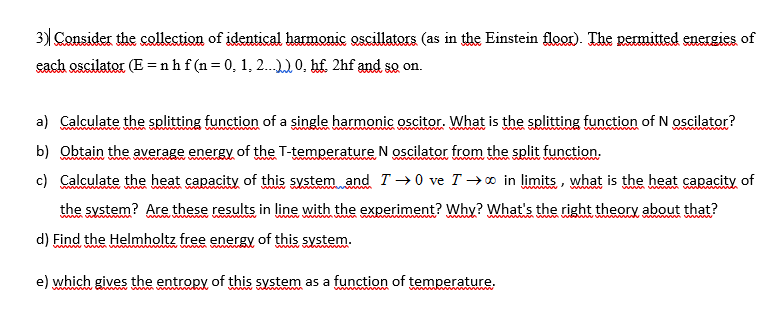a) Calculate the splitting function of a single harmonic oscitor. What is the splitting function of N oscilator? b) Obtain the average energy of the T-temperature N oscilator from the split function. c) Calculate the heat capacity of this system and T→ 0 ve T →∞ in limits, what is the heat capacity the system? Are these results in line with the experiment? Why? What's the right theory about that? d) Find the Helmholtz free energy of this system. e) which gives the entropy of this system as a function of temperature.
a) Calculate the splitting function of a single harmonic oscitor. What is the splitting function of N oscilator? b) Obtain the average energy of the T-temperature N oscilator from the split function. c) Calculate the heat capacity of this system and T→ 0 ve T →∞ in limits, what is the heat capacity the system? Are these results in line with the experiment? Why? What's the right theory about that? d) Find the Helmholtz free energy of this system. e) which gives the entropy of this system as a function of temperature.
Classical Dynamics of Particles and Systems
5th Edition
ISBN:9780534408961
Author:Stephen T. Thornton, Jerry B. Marion
Publisher:Stephen T. Thornton, Jerry B. Marion
Chapter14: Special Theory Of Relativity
Section: Chapter Questions
Problem 14.37P
Related questions
Question
100%

Transcribed Image Text:3) Consider the collection of identical harmonic oscillators (as in the Einstein floor). The permitted energies of
each oscilator (E = nhf (n=0, 1, 2.0, hf. 2hf and so on.
a) Calculate the splitting function of a single harmonic oscitor. What is the splitting function of N oscilator?
wwww
wwwwww
www www
b) Obtain the average energy of the T-temperature N oscilator from the split function.
c) Calculate the heat capacity of this system and T → 0 ve T → 0 in limits, what is the heat capacity of
the system? Are these results in line with the experiment? Why? What's the right theory about that?
w w
d) Find the Helmholtz free energy of this system.
www
ww
e) which gives the entropy of this system as a function of temperature.
ww wd
wwww ww
Expert Solution
This question has been solved!
Explore an expertly crafted, step-by-step solution for a thorough understanding of key concepts.
Step by step
Solved in 4 steps with 4 images

Knowledge Booster
Learn more about
Need a deep-dive on the concept behind this application? Look no further. Learn more about this topic, physics and related others by exploring similar questions and additional content below.Recommended textbooks for you

Classical Dynamics of Particles and Systems
Physics
ISBN:
9780534408961
Author:
Stephen T. Thornton, Jerry B. Marion
Publisher:
Cengage Learning

Modern Physics
Physics
ISBN:
9781111794378
Author:
Raymond A. Serway, Clement J. Moses, Curt A. Moyer
Publisher:
Cengage Learning

Principles of Physics: A Calculus-Based Text
Physics
ISBN:
9781133104261
Author:
Raymond A. Serway, John W. Jewett
Publisher:
Cengage Learning

Classical Dynamics of Particles and Systems
Physics
ISBN:
9780534408961
Author:
Stephen T. Thornton, Jerry B. Marion
Publisher:
Cengage Learning

Modern Physics
Physics
ISBN:
9781111794378
Author:
Raymond A. Serway, Clement J. Moses, Curt A. Moyer
Publisher:
Cengage Learning

Principles of Physics: A Calculus-Based Text
Physics
ISBN:
9781133104261
Author:
Raymond A. Serway, John W. Jewett
Publisher:
Cengage Learning

University Physics Volume 3
Physics
ISBN:
9781938168185
Author:
William Moebs, Jeff Sanny
Publisher:
OpenStax